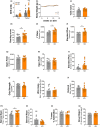2-month ketogenic diet preferentially alters skeletal muscle and augments cognitive function in middle aged female mice
- PMID: 36148631
- PMCID: PMC9577944
- DOI: 10.1111/acel.13706
2-month ketogenic diet preferentially alters skeletal muscle and augments cognitive function in middle aged female mice
Abstract
The effect of a ketogenic diet (KD) on middle aged female mice is poorly understood as most of this work have been conducted in young female mice or diseased models. We have previously shown that an isocaloric KD started at middle age in male mice results in enhanced mitochondrial mass and function after 2 months on diet and improved cognitive behavior after being on diet for 14 months when compared with their control diet (CD) fed counterparts. Here, we aimed to investigate the effect of an isocaloric 2-month KD or CD on healthy 14-month-old female mice. At 16 months of age cognitive behavior tests were performed and then serum, skeletal muscle, cortex, and hippocampal tissues were collected for biochemical analysis. Two months on a KD resulted in enhanced cognitive behavior associated with anxiety, memory, and willingness to explore. The improved neurocognitive function was associated with increased PGC1α protein in the gastrocnemius (GTN) muscle and nuclear fraction. The KD resulted in a tissue specific increase in mitochondrial mass and kynurenine aminotransferase (KAT) levels in the GTN and soleus muscles, with a corresponding decrease in kynurenine and increase in kynurenic acid levels in serum. With KAT proteins being responsible for converting kynurenine into kynurenic acid, which is unable to cross the blood brain barrier and be turned into quinolinic acid-a potent neurotoxin, this study provides a potential mechanism of crosstalk between muscle and brain in mice on a KD that may contribute to improved cognitive function in middle-aged female mice.
Keywords: Alzheimer's disease; acetylation; cognitive behavior; mitochondria; skeletal muscle.
© 2022 The Authors. Aging Cell published by Anatomical Society and John Wiley & Sons Ltd.
Conflict of interest statement
K. Baar and J Ramsey have received funding to study ketogenic diets from NIH. KB is a Scientific Advisor to KetoKind. Prof Baar has also received grants and donations from other nutritional companies such as PepsiCo, Bergstrom Nutrition, Ynsect, and GelTor.
Figures






References
-
- Agudelo, L. Z. , Femenía, T. , Orhan, F. , Porsmyr‐Palmertz, M. , Goiny, M. , Martinez‐Redondo, V. , Correia, J. C. , Izadi, M. , Bhat, M. , Schuppe‐Koistinen, I. , Pettersson, A. T. , Ferreira, D. M. S. , Krook, A. , Barres, R. , Zierath, J. R. , Erhardt, S. , Lindskog, M. , & Ruas, J. L. (2014). Skeletal muscle PGC‐1α1 modulates kynurenine metabolism and mediates resilience to stress‐induced depression. Cell, 159(1), 33–45. 10.1016/j.cell.2014.07.051 - DOI - PubMed
-
- Baar, K. , Wende, A. R. , Jones, T. E. , Marison, M. , Nolte, L. A. , Chen, M. , Kelly, D. P. , & Holloszy, J. O. (2002). Adaptations of skeletal muscle to exercise: Rapid increase in the transcriptional coactivator PGC‐1. FASEB Journal: Official Publication of the Federation of American Societies for Experimental Biology, 16(14), 1879–1886. 10.1096/fj.02-0367com - DOI - PubMed
-
- Christensen, D. G. , Xie, X. , Basisty, N. , Byrnes, J. , McSweeney, S. , Schilling, B. , & Wolfe, A. J. (2019). Post‐translational protein acetylation: An elegant mechanism for bacteria to dynamically regulate metabolic functions. Frontiers in Microbiology, 10, 1604. 10.3389/fmicb.2019.01604 - DOI - PMC - PubMed

